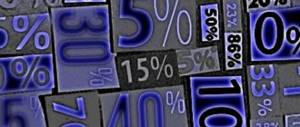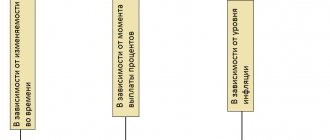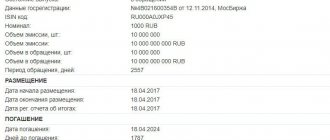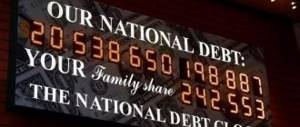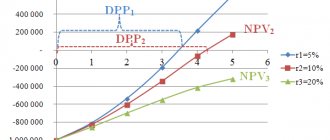Good day, fellow traders!
The topic of interest rates often appears on the agenda of various media, and many are already aware that this is closely related to the global economy and finance and somehow affects the processes occurring in the foreign exchange markets.
But what do interest rates actually mean and why do they affect Forex trends?
Below is a small analysis of the forces that drive monetary policy and trends in markets, including Forex.
Official interest rate of the central bank (discount rate, refinancing rate)
This is the interest rate at which the central bank issues loans to commercial banks. Those, in turn, issue loans to commercial companies, focusing on this official rate. If rates are high, then loans are more expensive, goods on the markets are also more expensive and therefore less competitive. The demand for loans falls, inflation slows down and, consequently, the currency rises in price.
And vice versa, if rates are low, then commercial banks and then companies take out loans at lower interest rates (sometimes negative), which allows them to sell goods cheaper, the Central Bank prints more money and inflation accelerates - the currency becomes cheaper.
What does the key rate affect?
When discussing what the key rate depends on, I propose to pay attention not only to the internal factors of the country, but also to macroeconomic ones around the world. The basic rule: the higher the key rate, the lower the inflation rate and the money can simply depreciate. A decrease in the rate leads to a decrease in the price level. But it is important to maintain a balance. The Central Bank has determined the key level below which the rate cannot be reduced, and it is 4%. Otherwise, there will be not just a slowdown, but practically stagnation of financial processes. As a result, the economy will not be able to keep up with the strong growth in demand, which will lead to economic collapse. I’ll explain with a simple example: in order to sell milk, you need to buy a calf (including by taking out a loan), feed it and wait until the cow gives milk, and this is all time costs.
Inflation
The higher the key rate, the slower the inflation; in essence, money depreciates more slowly, and prices should not fall so quickly. If the Central Bank takes such a decisive step, then many stores immediately raise prices, and the national currency falls in value. When you know what inflation is and its main characteristics, you can quickly figure out what exactly to do with ruble reserves.
Exchange Rates
If the key rate is low, then this is reflected in the wood exchange rate as follows:
- Banks are buying foreign currency.
- The foreign currency exchange rate decreases as many free rubles appear on the market.
This is the right time to invest in the ruble, since the process of raising and lowering rates is cyclical, which means that if the key rate is raised, the national rate will increase and currency speculation will no longer be profitable.
Interest on loans
If the rate is reduced, the interest rate on loans becomes more attractive, and the number of loans issued increases rapidly. At the same time, there is a situation of development of consumer philosophy, because often banks offer too favorable lending conditions, as a result, clients “buy” into this and do not always count on their financial capabilities.
Interest on deposits
Here the situation is the opposite. Since a private bank acts as a kind of layer between the Central Bank and the client, it needs to earn as much money as possible in order to repay its loan. Consequently, all efforts will be directed towards loans, and deposit rates in both rubles and foreign currency will decrease. That is why I do not recommend working exclusively with bank deposits as a passive source of investment, but using BCS investment tools, online projects, and crowdsurfing.
Bond quotes
Issuers place bonds at a price slightly above the prevailing rate. At the same time, the position of expectation is important: if the market is focused on the fact that the rate will rise, then current bonds become cheaper, because they will soon be replaced by more profitable ones. If rates are expected to decline, bonds become one of the most profitable investment instruments.
Taxation of individuals
A change in the key rate affects the amount of penalties for late payment of taxes and insurance premiums. The latest changes to the amount of penalties were made to the legislation of the Russian Federation in 2017. Currently they look like this:
- for individuals - 1/300 of the current refinancing rate;
- for organizations 1/300 of the rate up to 30 calendar days of delay;
- in case of delay, 1/300 of the current rate and 1/150 of the rate, which is valid starting from the 31st day of such delay.
Some methods of calculating tax are directly linked to the indicator, which are specified not only in the tax code, but also in the civil code.
Monetary policy: why and how rates are regulated
The stakes are high and low. However, these values are always relative, and therefore it is important to take into account historical dynamics and growth/decrease in relation to their own historical values.
Photo from the March meeting of officials of the US Federal Monetary Policy Committee (FOMC)
The central bank is raising rates to prevent the economy from overheating. This happens when there is no room for growth in the economy and prices begin to rise beyond the real increase in the production of goods and services, which leads to an acceleration of inflation and a decrease in the trading rate of the currency.
An increase in the rate slows down inflation and makes the currency more attractive in the eyes of investors, and commercial banks place investor funds on deposits at a higher interest rate.
The rate reduction, on the contrary, is stimulating in nature and serves to speed up economic processes, cheap loans for business, low taxes, reduce unemployment and increase business activity. This accelerates inflation and reduces the trading rate of the currency.
Where is it used and why is it needed?
A change in the key rate directly affects the work of banks, credit organizations, microfinance organizations, prices in the supermarket and, of course, the cost of real estate. In a way, this is a way for the state to control the rise in prices and inflation of the national currency. Among the main objectives of the key rate of the Central Bank of Russia are the following:
- reduction in inflation;
- achieving price stability;
- a push to increase investment in the economy.
It is also important to understand the difference between the key rate and the discount rate, because these concepts are equally important for the economy and the pocket of each of us. The refinancing rate at the legislative and practical level was first introduced in 1992, the accounting rate - 11 years later. The first shows the average interest rate at which the Central Bank issues short-term, weekly loans to private banks. The size of fines and taxes directly depends on this value.
Starting from December 17, 2021, the Central Bank leveled the refinancing and discount rates. The current figure is 6%.
When and how often are rates adjusted?
Central banks independently determine the timing of interest rate revisions. For example, in the USA the rate is regulated by the Federal Open Market Committee (FOMC). And needless to say, the whole world is watching their meetings. And usually special committees of national central banks adopt one or another monetary rate at the beginning of the financial year, but if something happens they can change it later.
In the EU, the refinancing rate is regulated by the European Central Bank. In Great Britain - by the Bank of England. In Japan - by the Bank of Japan and so on. The markets also take into account rates from Switzerland, Canada, the RBA, Norway, China, India, Korea and individual European countries such as France, Italy, Germany, Spain and others.
You can find out more about the current interest rates of various banks here.
How to predict exchange rate changes as a result of rate increases
You can predict changes in the exchange rate of a particular currency in a variety of ways, the most reliable of which are the following:
- Conducting fundamental analysis.
- Track interest rate changes.
The latter is the most reliable way to determine the reasons for changes in the price level of a particular currency.
So, in some cases, an increase in interest rates leads to a sharp jump in prices, in others the jump occurs only for a short time, in others - the price, on the contrary, falls, here it all depends on the economy of the country in which these changes occur, as well as on whether the whether the exchange rate was artificial before the rates were raised. To determine exactly where the price jump will be, you need to constantly monitor the movement of price levels and identify their connection with news releases.
I hope this article will help you become a successful Forex trader. To stay up to date with all modern strategies and tools, subscribe to my newsletter.
What's happening in the Forex market
If you opened the economic calendar and found that officials of any national central bank are meeting to make a decision on interest rates, then rates may change and change the trend, depending on whether they are lowering or increasing.
Or rates may remain at the same level, and then the trend will be determined based on the current dynamics: if the rates were reduced the previous time, then the trend will be bearish, and if they were raised, then the trend will be bullish.
Typically, prospects for rate increases or cuts are announced repeatedly over long periods of time before they are changed. Long-term investors and position traders use this to make a profit or, conversely, to avoid risks.
Will the Central Bank cut rates again?
Since the current slowdown in inflation is associated with weak dynamics of real incomes of the population, it can be assumed that price growth will continue to slow down, and the Central Bank will have grounds for further easing of monetary policy.
Following this, banks will reduce rates on consumer loans and mortgages, although the speed of response to changes in the policy of the Central Bank of the Russian Federation will also slow down. Moreover, domestic banks are not used to working in low interest rates. Therefore, you should not expect a sharp drop in the cost of loans, although a trend towards this will be visible. Those who have a mortgage loan can refinance their debts today, although it makes sense to wait for further easing of the Central Bank's policy and the banks' reaction to this event. If the regulator’s rate falls below 6.0%, this could lead to another boom in consumer lending. This is not a reason to get involved in long-term financial loans. The economic situation may change within 3-5 years, so the main rule of the borrower should remain caution.
Negative interest rates
In the table of interest rates of central banks, you can see that the level of the refinancing rate in Switzerland, Sweden and Japan is a negative value. What does this mean and for what purpose does the state do this? Everyone knows that Swiss banks are the most reliable financial and credit institutions in the world. It is not surprising that during the crisis in the European Union, investors redirected their capital to Swiss banks, which led to a sharp increase in the value of the national currency. In order to support its own economy, the Swiss authorities have established a fee for placing funds in their banks. Sweden followed suit.
Japan's economy is largely export-oriented, so the high exchange rate of the local currency is unprofitable for the country. Thanks to the reduction in the refinancing rate, the Central Bank of Japan is pursuing a long-term policy that limits the growth of the local currency relative to the European and American ones.
Central bankers are banging their heads against the wall
In theory, it is not difficult to understand what a negative interest rate is. If you borrow money at a positive rate, you get back more than you gave. If the rate is negative, you will receive less money than you originally lent. In other words, you will pay to store your own funds. So in theory everything is simple.
In practice, this phenomenon looks absurd and paradoxical, and therefore difficult to comprehend. When you borrow funds, you are the one who expects to receive interest. You have money that someone needs, so why should you pay for it?
This is the essence. If you are paid to borrow, but on the contrary, they ask for money to save, who will want to save when they can borrow? At least, this is the logic that central banks use.
In practice, it works like this: banks pay for storing money with the central bank, and this encourages them (in theory) to issue more loans. They can pass these costs on to large investors, but until now, ordinary investors like you and me have been spared (we don't get any interest anyway).
Again, in theory, if we borrow and spend rather than save and save, the economy and inflation will grow faster and all will be right with the world again. None of this is all that different from what the central bank has been saying for years: lower rates mean more borrowing and therefore more consumption and activity. It seems they still haven't lost faith in this mantra, even though it doesn't work.
Negative interest rates are nothing new, as they have been in place for a long time in Japan, the eurozone and Switzerland. Even those who rarely take an interest in global macroeconomics know that the eurozone and Japan are known for their lack of inflation, not for their buoyant, overheated economies.
But how can this affect an investment portfolio?
Where else is the key rate applied?
The key rate is used in many other places:
- in calculating the fine for late tax payments - during the first 30 days, the violator will be charged a penalty in the amount of 1/300 of the key rate for each day of delay, and after 30 days they will be charged 1/150;
- when calculating penalties for late payment of a loan, non-payment of housing and communal services, etc.;
- when calculating penalties for late payment under a contract (for example, when delivering equipment) - they usually take 1/100 or 1/50 for each day of delay;
- when calculating late fees when paying alimony, claims and other payments;
- when calculating tax on the use of an interest-free loan (or a loan with a rate below 2/3 of the key rate);
- when calculating interest for the use of borrowed money (if the contract does not specify a rate).
In a word, the key rate is “hardwired” into the economy, tax and debt payments, and really affects a lot of things - and not just inflation and the return on deposits.
Policy and signals of the Central Bank of the Russian Federation
Periodic changes in the key rate must coincide with economic cycles, reflecting both the foreign and domestic financial policies of the state. A timely increase or decrease in the key rate by several basis points allows increasing liquidity or reducing the money supply, stimulating the consumer to spend or save money.
By analyzing the actions of the Central Bank, you can predict the direction of policy and make money on it. If the government lowers the key rate, it means there is enough liquidity in the treasury to issue loans, and demand is at a level that requires an increase in production volume. Since the value of the national currency decreases when the key rate is low, you can make money by buying foreign currency or selling ruble assets to buy them at a more attractive price. Conversely, a growing key rate is a reason to sell foreign currency or accumulate securities of domestic companies, the price of which will rise.
You should not compare systematic fluctuations of the key rate of several basis points and sudden jumps of several units or even tens of percent. An increase or decrease in the key rate by more than 1% already indicates the presence of crisis phenomena. In this case, you should refrain from purchasing risky assets and keep capital in cash (accounts, deposits). The direction of changes in the key rate will eloquently indicate which is better, foreign currency or the ruble.
What will happen if rates increase
So, we now live in an era of ultra-low key rates in the economy. Cheap loans, low inflation and high stock market returns have weakened and spoiled both us investors and businesses.
Getting a loan in developed countries for almost any business is a piece of cake. Even dubious enterprises with minimal margins have every chance of making money. If something goes wrong, you can always take out another loan (and even at an even lower rate and for a larger volume). As a last resort, you can hold an IPO - investors will throw in money =)
Is the IPO boom happening in an era of zero key rates for nothing? Think about it.
But what will happen if (or even: when) Central banks start raising rates? After all, the same inflation, for example, in the USA, has already begun its run-up (I’m generally silent about Russia). Sooner or later, inflation will return to both Europe and Japan. Rising inflation in China is a different story altogether.
In order to keep inflation within a normal range (within 2-3% - this is considered normal), the same Fed will have to increase the interest (key) rate, i.e. hawkish monetary policy will begin to be implemented.
Loans will instantly become more expensive, deposits will become more profitable. The price of treasuries will fly down, as the US Treasury will issue debt securities with higher yields, and no one will need the old treasuries with a coupon of 0.5%.
Weak businesses with small margins and/or high debt loads will be washed away immediately. According to Buffett's apt expression, it will become clear who swam without panties. Companies with large debts will not be able to restructure their debts - they will either have to go bankrupt or re-borrow on worse terms and end up paying more and more money to creditors, reducing their own cash flows - and in the end they will still go bankrupt. Or you will have to create a truly revolutionary product. Or you will have to make tough savings and cut operating expenses (think: not paying salaries to employees and saving on raw materials).
Bankruptcies of companies will cause defaults of banks to which these same companies owe money, and will also provoke a sharp increase in unemployment. The unemployed will not be able to take out loans to live on something or to start their own project: it is too expensive. The purchase of goods will begin, as a shortage will arise - hence the rise in inflation, currency devaluation and, possibly, even the default of the state (and of any kind - be it Russia or the United States).
Yes, the scenario is a little apocalyptic, but quite possible.
In short, no one needs an increase in the key rate now, when neither business nor the government is ready to “restart” the economy. However, the delay in the “restart” entails a further increase in internal problems. There is more and more hidden unemployment in countries, and in the stock market - shell companies, zombie companies and companies paying dividends from debt. The abscess is ripening - and sooner or later it will explode so that, mother, don’t worry.
This is why messages and hints from the heads of central banks on the eve of the next meeting acquire such weight. The whole world is tense: everyone is waiting to see whether the world's central banks will take decisive steps to implement hawkish monetary policies - or are we still waiting?
What do you think: is it worth raising the key rate in Russia and the USA or should we wait a little longer? Write in the comments! Good luck, and may the money be with you!
Rate this article
[Total votes: 6 Average rating: 4.8]
Betting statistics for recent years
On the day of commissioning January 1, 1992. The refinancing rate was 20%, and was growing steadily. In the 90s, maximum values of 200% were recorded. The Central Bank’s instrument reached double-digit values only in the 2000s.
Statistics for recent years are as follows:
- in the period from September 13, 2013 to March 2, 2014 the rate was stable - 5.50%;
- from March 3, 2014 to April 27, 2014 it increased by 1.5% and amounted to 7%;
- from April 28, 2014 to July 27, 2014, and from July 28, 2014 to November 4, 2014 the discount rate gave an increase of 0.5% for the period - 7.50% and 8.00%, respectively;
- from November 5, 2014 to December 11, 2014 — 9.50%;
- in December, from December 12, 2014 to December 15, 2014 and from December 16, 2014 until February 1, 2015 the rate changed twice - 10.50% and 17.00%;
- from February 2, 2015 to May 4, 2015 has already dropped to 14.00%;
- from May 5, 2015 to August 2, 2015 continued to decline to 11.50%;
- from August 3, 2015 decreased by 0.5% three times and was equal to March 26, 2021. 10.00%.
- from March 27, 2021 until September 17, 2021 there was a loss of another 1% and the value was 9.00%;
- from September 18, 2021 until December 17, 2021 not a significant decrease - 8.25%;
- from December 18, 2021 until September 16, 2021 the indicator decreased three times and reached a value of 7.25%;
- from September 17, 2021 until October 28, 2021 — 7.5%, the first significant increase since February 2015.
In addition to the above tasks, the discount rate has one more option. The rate is a tool to combat currency speculation. The goal is to ensure that currency speculation does not bring in excess profits. Although the Central Bank itself often creates a panic on the currency exchanges in order to compress the ruble money supply and contain the rapidly growing inflation. In addition, it is not only a financial instrument, but also a clear indicator of monetary policy.
